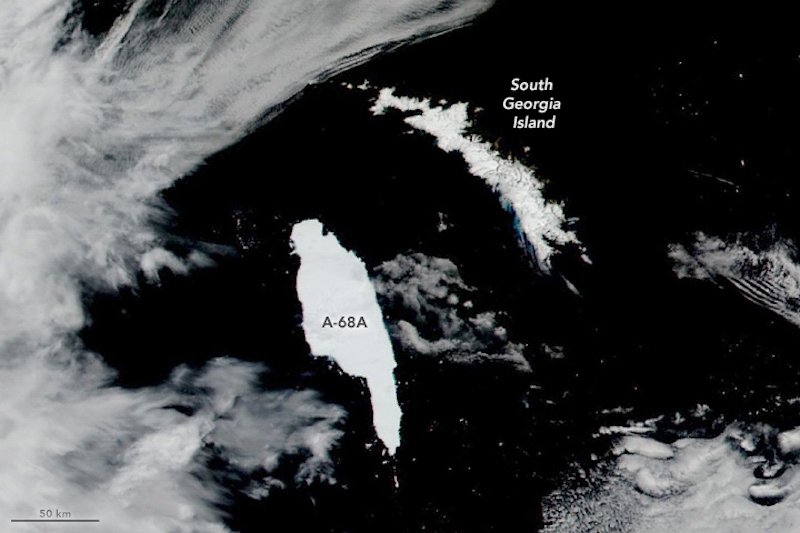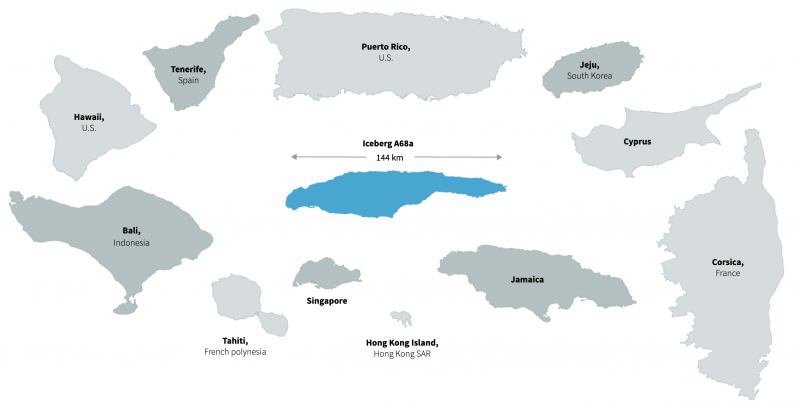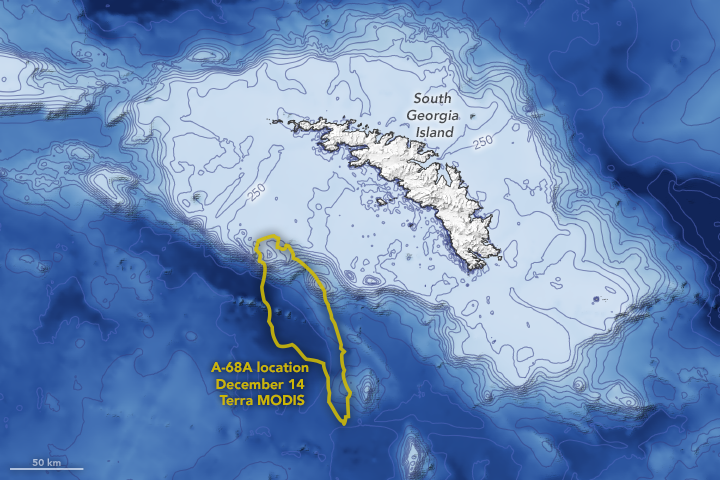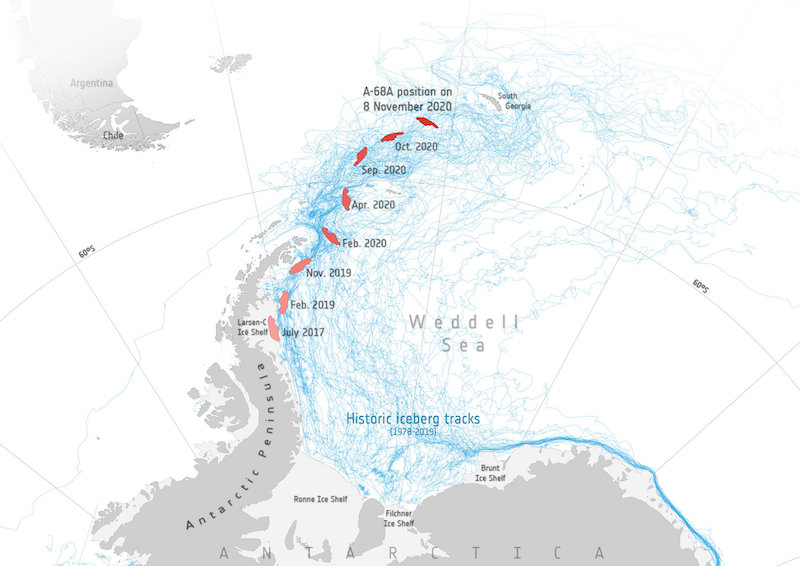
Antarctic iceberg A-68A, the biggest iceberg on Earth, is now moving straight toward South Georgia Island, a remote, uninhabited south Atlantic island populated by seals and penguins. Scientists think the giant berg could collide with the island this month, wreaking havoc near the island’s waters.
The iceberg first broke from Antarctica’s Larsen C Ice Shelf in July 2017. Since then, it has traveled thousands of miles, and on Monday, December 14, 2020, lay around 75 miles (120 km) from South Georgia Island. If it stays on its current path, the iceberg – which is about the same size as the island itself – could ground in the shallow waters offshore this month, and cause real problems for the island wildlife and seafloor-dwelling life.
South Georgia Island is a British Overseas Territory in the South Atlantic. It’s part of a chain of smaller islands, known as the South Sandwich Islands.
EarthSky 2021 lunar calendars now available! They make great gifts. Order now. Going fast!

A68-A on December 14, 2020. Image via NASA.

The size of A-68A compared to islands from around the world. Image via Reuters.
As the berg drifts menacingly close to South Georgia Island, scientists around the world are watching to see what the berg will do next. According to NASA’s Earth Observatory:
The concern is that the iceberg has approached the edge of the island’s submarine shelf—an area where waters become relatively shallow, measuring less than 200 meters (650 feet) deep. Scientists think the iceberg extends about that far below the water line, meaning it has the potential to snag the seafloor and become “grounded.” Biologists worry about the potential effect a grounded iceberg could have on the island’s wildlife, such as the ability for penguins to access food.
Penguins and seals need access to the sea to feed so the iceberg could easily block their foraging routes and life on the seafloor could be crushed if the berg grounds. The fear, according to ESA scientists, is that if the berg does anchor against the South Georgia coast, it could remain there for up to 10 years.

Position of A-68A relative to the shallow waters around South Georgia Island December 14, 2020. Image via NASA.

The track of iceberg A-68A along “Iceberg Alley”. Image via ESA.
In just over three years at sea, Iceberg A-68A has moved generally northward, passing the tip of the Antarctic Peninsula and floating into what’s called “Iceberg Alley.” David Long, a remote sensing and polar ice scientist at Brigham Young University, has been tracking A-68A’s journey. He said that although more than 90% of all Antarctic icebergs are swept along this path from the Weddell Sea toward the South Atlantic Ocean, most just don’t survive the journey from the Weddell to South Georgia Island. But A-68A’s huge size has helped it survive the relatively warm, iceberg-killing waters of the South Atlantic that shrink and break up lesser bergs.
In recent days, a clockwise rotation has appeared to move one end of the berg over the shelf and into shallow waters. Klaus Strübing, a scientist with the International Ice Charting Group, who’s been using satellite data to track the berg, thinks the iceberg might already be grounded. He reported that as of December 13, part of the iceberg was in waters just 245 feet (76 meters) deep. Time will tell if A-68A will stall on the shelf, or if the region’s complex ocean currents will carry the berg back out to sea and around the island.
Bottom line: Antarctic iceberg A-68A, the biggest iceberg on Earth, is now (mid December 2020) moving straight toward South Georgia Island, a remote, uninhabited south Atlantic island populated by seals and penguins. Scientists think the giant berg could collide with the island this month, wreaking havoc for living ecosystems near the island’s waters.
from EarthSky https://ift.tt/3oSQG0O

Antarctic iceberg A-68A, the biggest iceberg on Earth, is now moving straight toward South Georgia Island, a remote, uninhabited south Atlantic island populated by seals and penguins. Scientists think the giant berg could collide with the island this month, wreaking havoc near the island’s waters.
The iceberg first broke from Antarctica’s Larsen C Ice Shelf in July 2017. Since then, it has traveled thousands of miles, and on Monday, December 14, 2020, lay around 75 miles (120 km) from South Georgia Island. If it stays on its current path, the iceberg – which is about the same size as the island itself – could ground in the shallow waters offshore this month, and cause real problems for the island wildlife and seafloor-dwelling life.
South Georgia Island is a British Overseas Territory in the South Atlantic. It’s part of a chain of smaller islands, known as the South Sandwich Islands.
EarthSky 2021 lunar calendars now available! They make great gifts. Order now. Going fast!

A68-A on December 14, 2020. Image via NASA.

The size of A-68A compared to islands from around the world. Image via Reuters.
As the berg drifts menacingly close to South Georgia Island, scientists around the world are watching to see what the berg will do next. According to NASA’s Earth Observatory:
The concern is that the iceberg has approached the edge of the island’s submarine shelf—an area where waters become relatively shallow, measuring less than 200 meters (650 feet) deep. Scientists think the iceberg extends about that far below the water line, meaning it has the potential to snag the seafloor and become “grounded.” Biologists worry about the potential effect a grounded iceberg could have on the island’s wildlife, such as the ability for penguins to access food.
Penguins and seals need access to the sea to feed so the iceberg could easily block their foraging routes and life on the seafloor could be crushed if the berg grounds. The fear, according to ESA scientists, is that if the berg does anchor against the South Georgia coast, it could remain there for up to 10 years.

Position of A-68A relative to the shallow waters around South Georgia Island December 14, 2020. Image via NASA.

The track of iceberg A-68A along “Iceberg Alley”. Image via ESA.
In just over three years at sea, Iceberg A-68A has moved generally northward, passing the tip of the Antarctic Peninsula and floating into what’s called “Iceberg Alley.” David Long, a remote sensing and polar ice scientist at Brigham Young University, has been tracking A-68A’s journey. He said that although more than 90% of all Antarctic icebergs are swept along this path from the Weddell Sea toward the South Atlantic Ocean, most just don’t survive the journey from the Weddell to South Georgia Island. But A-68A’s huge size has helped it survive the relatively warm, iceberg-killing waters of the South Atlantic that shrink and break up lesser bergs.
In recent days, a clockwise rotation has appeared to move one end of the berg over the shelf and into shallow waters. Klaus Strübing, a scientist with the International Ice Charting Group, who’s been using satellite data to track the berg, thinks the iceberg might already be grounded. He reported that as of December 13, part of the iceberg was in waters just 245 feet (76 meters) deep. Time will tell if A-68A will stall on the shelf, or if the region’s complex ocean currents will carry the berg back out to sea and around the island.
Bottom line: Antarctic iceberg A-68A, the biggest iceberg on Earth, is now (mid December 2020) moving straight toward South Georgia Island, a remote, uninhabited south Atlantic island populated by seals and penguins. Scientists think the giant berg could collide with the island this month, wreaking havoc for living ecosystems near the island’s waters.
from EarthSky https://ift.tt/3oSQG0O

Aucun commentaire:
Enregistrer un commentaire